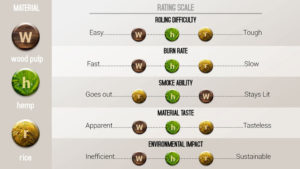 There’s an abundance of rolling papers on the modern market today – from traditional Zig-Zags to 24 karat gold papers, it can be a daunting task to pick the ‘best’ pack. Ultimately, there is no ‘best’, it all comes down to personal preference. Below, we break down the major types of paper materials to help you identify the paper that meets your joint rolling and smoking preferences.
There’s an abundance of rolling papers on the modern market today – from traditional Zig-Zags to 24 karat gold papers, it can be a daunting task to pick the ‘best’ pack. Ultimately, there is no ‘best’, it all comes down to personal preference. Below, we break down the major types of paper materials to help you identify the paper that meets your joint rolling and smoking preferences.
The major factors to consider when evaluating potential papers include rolling difficulty, burn rate, smoke-ability, taste, and environmental impact.
Wood Pulp
The very first rolling papers were likely made using wood pulp – the same material as printer paper and cigarettes. They are arguably the easiest papers to use when learning to roll a joint and certainly the most common, you can find them anywhere. They stay lit through a storm and maintain a medium to fast burn rate. Unfortunately, they are usually the worst tasting paper variety with the most noticeable aftertaste. This subsequently means they produce the most ash, burning less cleanly and contaminating your smoke. They are the lowest quality papers from an environmental and personal health perspective.
Traditional wood pulp papers can be 100% wood pulp or partially blended with flax – a quick Google will tell you the composition of nearly any brand. Wood pulp papers are either bleached with calcium carbonate or chlorine (they will appear white) or unbleached (brown or translucent). As a general rule of thumb, the less processed the papers are, the less you notice that unnatural, burnt-paper-taste. You can find wood pulp papers in a variety of thicknesses and flavors.
Hemp
Hemp papers are typically made from 100% hemp fiber and most are unbleached. Hemp papers can be found in a variety of thicknesses, but as a general rule of thumb, they have a thicker, more texturized feel than rice papers. The texturized feel of hemp papers provides good grip and makes for relatively easy joint rolling. Hemp stays lit better than rice paper and adds a mild, pleasant, taste some may describe as sweet or musky. As a bonus, hemp rolling papers are the most environmentally conscious option.
Rice
Rice paper is made with processed rice and can include other additives such as sugar and flax. Rice is the thinnest of the major paper types, and therefore results in the least noticeable taste and the slowest burn. The thin, smooth texture of rice papers can make them a challenge to roll joints with, but the reward is a slow burning paper with little to no taste. On the downside, it may go out if not constantly smoked.
Comparison
 While we have covered the most common rolling paper materials, there are other novelty rolling papers as well. Some incorporate gold flakes while others are infused with artificial flavors. There are also transparent rolling papers made of cellulose. While these papers are fun on occasion, we don’t recommend them for the everyday smoker. We can help you roll slower burning joints by flipping the paper inside out, perfect your style with cone vs pinner tips, increase the potency of your joints by adding cannabis concentrates to create what’s known as a twax joint. Twaxing comes in handy when you need to share a small joint with a lot of people. By adding some BHO or even kief from your grinder, you can boost its potency and increase the joints share-ability. If you don’t have access to concentrates, you can even make your own dabs at home!
While we have covered the most common rolling paper materials, there are other novelty rolling papers as well. Some incorporate gold flakes while others are infused with artificial flavors. There are also transparent rolling papers made of cellulose. While these papers are fun on occasion, we don’t recommend them for the everyday smoker. We can help you roll slower burning joints by flipping the paper inside out, perfect your style with cone vs pinner tips, increase the potency of your joints by adding cannabis concentrates to create what’s known as a twax joint. Twaxing comes in handy when you need to share a small joint with a lot of people. By adding some BHO or even kief from your grinder, you can boost its potency and increase the joints share-ability. If you don’t have access to concentrates, you can even make your own dabs at home!
Protect Your Rolling Papers
Once you have found your favorite rolling papers, be sure to protect them and the rest of your supplies in the smell-proof Safety Case. Its smell-proof design keeps your stash a secret, and secures all your key rolling components.





